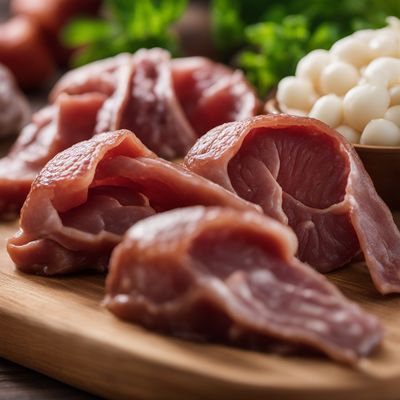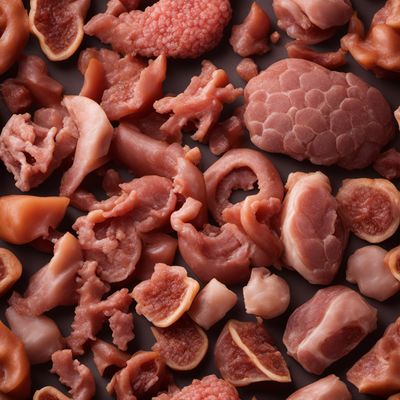
Ingredient
Mammals edible offal, non-muscle, other than liver and kidney
Exploring the Hidden Delicacies: Unveiling the World of Mammals' Edible Offal
Mammals edible offal, non-muscle, other than liver and kidney, includes various parts such as heart, lungs, sweetbreads, tripe, and tongue. These offal cuts possess distinct characteristics, with flavors ranging from rich and gamey to delicate and tender. The texture can vary from tender and melt-in-your-mouth to slightly chewy or gelatinous. Their appearance may differ, with some cuts having a smooth surface while others exhibit intricate patterns or unique shapes.
Origins and history
The consumption of mammals' edible offal dates back centuries and is deeply rooted in many cultures around the world. Offal has been a valuable source of nutrition, especially during times when food scarcity was prevalent. Different cultures have developed their own traditional dishes using offal, showcasing the resourcefulness and creativity of their culinary heritage.
Nutritional information
Mammals' edible offal, non-muscle, other than liver and kidney, is a nutrient-dense ingredient, providing essential vitamins and minerals such as iron, zinc, vitamin B12, and folate. It is also a good source of high-quality protein.
Allergens
Some individuals may have allergies or sensitivities to specific offal cuts, such as tripe or sweetbreads. It is important to be cautious and consult with a healthcare professional if you have any concerns.
How to select
When selecting mammals' edible offal, non-muscle, other than liver and kidney, look for cuts that are fresh, firm, and free from any unpleasant odors. Avoid offal with discoloration or signs of spoilage. If possible, choose offal from reputable sources that prioritize animal welfare and sustainable practices.
Storage recommendations
To maintain the freshness and quality of mammals' edible offal, non-muscle, other than liver and kidney, it is best to store it in airtight containers or sealed bags in the refrigerator. Use it within a few days of purchase to ensure optimal taste and texture.
How to produce
Producing mammals' edible offal, non-muscle, other than liver and kidney, requires specialized knowledge and expertise. It is typically done in professional settings, such as abattoirs or meat processing facilities, where the offal is carefully harvested, inspected, and prepared for distribution.
Preparation tips
Before cooking, it is essential to properly clean and trim the offal, removing any excess fat, membranes, or connective tissues. Offal can be prepared using various cooking techniques such as grilling, braising, frying, or stewing. Marinating offal cuts can help enhance their flavors and tenderize the meat. It is important to follow specific recipes and cooking instructions for each type of offal to achieve the best results.
Culinary uses
Mammals' edible offal, non-muscle, other than liver and kidney, is widely used in traditional dishes around the world. Heart can be grilled or braised, lungs are often used in soups or stews, sweetbreads are prized for their delicate flavor and are commonly pan-fried or roasted, tripe is a key ingredient in many regional dishes, and tongue can be braised or pickled. These offal cuts add depth and complexity to dishes, elevating the overall flavor profile.
Availability
Mammals' edible offal, non-muscle, other than liver and kidney, is commonly available in butcher shops, specialty meat markets, and some supermarkets. Its availability may vary depending on the region and local culinary traditions.
More ingredients from this category

Wild boar edible offal, non-muscle, other than liver and kidney
Savory Treasures from the Wild

Pig edible offal, non-muscle, other than liver and kidney
Beyond the Ordinary: Exploring the Versatility of Pig Edible Offal

Equine edible offal, non-muscle, other than liver and kidney
Exploring the Hidden Gems of Equine Edible Offal

Bovine edible offal, non-muscle, other than liver and kidney
The Hidden Gems of Bovine Offal

Deer edible offal, non-muscle, other than liver and kidney
The Hidden Gems of Deer: Exploring Non-Muscle Edible Offal

Sheep edible offal, non-muscle, other than liver and kidney
Exploring the Delicacies of Sheep Edible Offal

Goat edible offal, non-muscle, other than liver and kidney
The Hidden Gems of Goat: Exploring the Delicacies of Edible Offal

Rabbit edible offal, non-muscle, other than liver and kidney
Unveiling the Hidden Gems: Exploring the Versatile Rabbit Edible Offal

Camel edible offal, non-muscle, other than liver and kidney
Unveiling the Hidden Gems: Exploring the Exquisite Camel Edible Offal